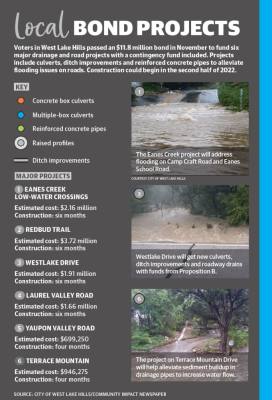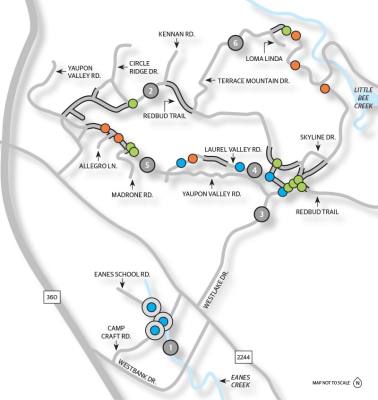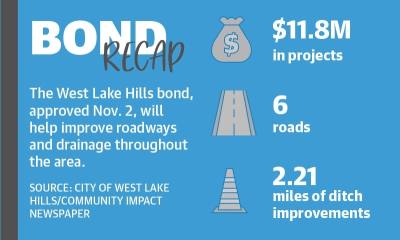Through Proposition B, voters of West Lake Hills allotted $11.8 million for permanent public improvements to six major roads in the city, two of which serve as arterial roads. Drainage upgrades, ditch improvements and road repair vary for each project, and in coming months the order of projects will be determined to limit the impact construction will have on residents.
The six major roads in question are Camp Craft Road, Laurel Valley Road, Redbud Trail, Westlake Drive, Yaupon Valley Road and Terrace Mountain Drive. These projects range from $699,250 to $3,724,525 with the project on Yaupon Valley being the cheapest and the project on Redbud being the most expensive.
“It brings us the reality of safer, better roads and safer, better buildings that each will bring more functionality to the community,” Mayor Linda Anthony said. “This is a big win for everyone in West Lake Hills because our roads are in terrible shape. This is a giant step forward for us.”
Council will discuss a tentative timeline for projects Jan. 12 with K Friese + Associates, the city’s engineering firm. Projects will likely begin construction in the second half of 2022 and continue into 2023, said Travis Askey, city administrator of West Lake Hills.
Road work ahead
Like the rest of Austin, West Lake Hills is no stranger to floods. Little Bee Creek and Eanes Creek are two major sources of flooding, which became apparent during the drought-ending flood events of October 2015. Those flood events left Camp Craft Road underwater, with Westlake Drive facing similar problems as water levels approached the roadway, according to city documents.
Camp Craft and Eanes School Road have low-water crossings near Eanes Elementary School, meaning that water often floods the road during rain events due to flooding in nearby Eanes Creek. To remedy this, the $2.1 million project will raise the profiles of Camp Craft and Eanes School roads. Camp Craft will be raised by 6 feet at its low point, while Eanes School will be raised by 1.5 feet.
Similar to the Eanes Creek project, most bond projects focus on drainage, with over 2 miles of ditch improvements, city documents show. These include 23 multiple box culverts, which are concrete structures under the roadway aimed at increasing water flows. Several of the roads also include pavement repairs.
“You’re not only trying to improve the street, but you’re trying to capture the adverse impact during a heavy rain event,” Askey said. “West Lake Hills is unique because of its topography; it’s not like putting a city street on a level piece of property.”
With Redbud being the most expensive project, city documents show the road is set to receive roughly 6,500 feet of ditch improvements, new cross culverts and a 2- to 3-foot high retaining wall to properly direct water movement.
Understanding bonds
Anthony said trying to fund such large road projects with the city’s general fund that comes from property tax and other revenues is very difficult, given these projects often carry a high price tag. The alternative to using the general fund to fund projects is issuing bonds, which generate money for the city through investors.
“Whenever you put the bids on the street for the six projects that were approved, one of the first questions contractors have is if you have the money available,” Askey said. “This is a pretty complex bid with six separate packages and a substantial amount of money.”
Following the passage of the bonds Nov. 2, city staff will work in coming months to draft a preliminary official statement disclosing financial specifics of the bonds prior to their sale to investors. These financial elements include interest rates and payments, maturity dates and bond yields.
Propositions A and B are both general obligation bonds and are paid for with property taxes levied by the city. Askey said the city wants to take advantage of the historically low interest rates available to make the overall cost of the bonds and the cost to residents less.
As part of the competitive bidding process, the city will release a document stating what kind of offer it is looking for to finance the bonds. Investors will then respond with their offers, outlining interest rates, terms and conditions, and other details of the contract, Askey said. The city could accept a bid offer by March.
A major cost of the projects is moving the equipment to where it needs to be, Askey said, and the city hopes to mitigate those costs by strategically choosing the order of projects to maximize efficiency while keeping the impact to those using the roads minimal. For example, the city could not work on Westlake Drive and Redbud Trail simultaneously without causing massive disruption to through-traffic, Anthony said, as they both serve as main roadways for those going from one urban area to another in the city.
Though each of the six projects are technically their own packages, ideally the bonds would be sold to a single investor to streamline operations, Askey said. Awarding the multi-package bid to multiple investors would require more time and coordination among investors and the city.
Effect on community
West Lake Hills is the only city located completely within Eanes ISD boundaries, according to city and school documents. Though bus routes are not particularly impacted by the frequent flooding of the area, buses will still be impacted by road and lane closures, EISD Chief Operations Officer Jeremy Trimble said. This could potentially cause delays or shut off access to some roads altogether.
To mitigate this, the school is working with the city to establish the best plan moving forward to limit delays and closures due to construction. One way they can do this is by not having construction teams work during peak traffic hours in the early morning or mid-afternoon. In the past, the transportation team at EISD has worked around previous projects on roads such as Camp Craft Road by establishing alternate bus routes.
“It’s been a long time coming,” Trimble said. “While it’s a struggle, we understand that it’s a temporary situation. As long as we know ahead of time, we can make those accommodations and actually communicate with our community if something is going to change.”
The Westlake Fire Department has similarly been well-acquainted with the task of dodging potential road hazards due to flooding and construction, making the coming changes unlikely to impact response times to emergency calls, Fire Chief David Wilson said.
“One of the biggest improvements with the city doing these bonds is consistent access in an emergency,” Wilson said. “We don’t have to change as much with our response once it’s been raining a long time or we get those really heavy storms.”
In addition to propositions A and B, voters also approved Proposition C that will create a dedicated road repair fund to maintain municipal roads over time. Repairs will be fueled by changing a 0.5% sales tax currently used for property tax relief into a tax for maintenance and repair of municipal streets, a task Anthony said is one of the most costly projects the city is responsible for completing.
“I don’t think people truly appreciate how expensive road maintenance is,” Anthony said. “This puts us in a much better financial place. Prevention always costs less than coming back afterwards.”









